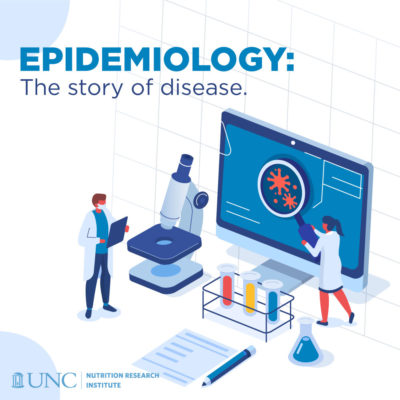Every good story includes the “5 Ws”: who, what, where, when, and why. In studying how disease begins and remains in a population, we’re writing the story of that disease, and we use the same technique. Understanding the various approaches to the “5 Ws” of a given disease can lead to a tailored intervention and prevention.
Epidemiology is academically defined as “the study of the occurrence and distribution of health-related states or events in specified populations, including the determinants influencing such states, and the application of this knowledge to control the health problem.” While this definition is accurate, it is complex. We can break it down into the “5 Ws” to get a better understanding.
occurrence and distribution: where/when
health-related states: what
populations: who
determinants influencing: why
In epidemiology, we add a sixth question: How? This tells us how to apply this knowledge.
In simpler terms, epidemiology is the story of a disease that we use to improve health and wellbeing in a population. How is this different from medicine? A physician looks at an individual, whereas an epidemiologist looks at an entire community. While both aim to find a diagnosis, a physician will care for and treat an individual. An epidemiologist is concerned about disease exposure to the larger population and putting measures in place to stop it from spreading further.
Determining the where, when, what and who can be somewhat simple, but determining why is often incredibly complex and takes a team of professionals to get the answer. An epidemiologist assesses whether groups with different rates of disease differ in their demographic characteristics, genetic or immunologic make-up, behaviors, environmental exposures or other so-called risk factors. In this explanation we already see five factors that could influence the outcome we’re researching, but then we also have “so-called risk factors” at the end leaving an open-ended search.
Using tooth loss as an example, some of the causes and factors would be gender, age, diet, obesity, diabetes, and dentist visits. While each of these individually can be directly related to tooth loss, they can also be related to one another. This creates a tangled web of causes and factors for an epidemiologist to consider.
Not only does the scientist have to untangle the web, they also must avoid confounding factors. Confounding is an important concept in epidemiology, because, if present, it can cause an over- or under- estimate of the observed association between exposure and health outcome. The distortion introduced by a confounding factor can be large, and it can even change the apparent direction of an effect. For example, you could surmise that ice cream causes sunburns because every time you eat it you end up with a sunburn. But if you look more deeply into the problem, you’ll see that ice cream is not causing a sunburn, but rather the sun itself because you only eat ice cream while sitting outside in the sun. Association does not equal causation.
An epidemiologist can only get the causation (“why”) when exposure comes before the outcome and the relationship cannot be explained by any other factor.
Julie Hasken, PhD, MPH, is a postdoctoral research fellow with Philip May, PhD at the UNC Nutrition Research Institute. She uses epidemiology to focus on the prevalence, child characteristics, and maternal risk factors of fetal alcohol spectrum disorders (FASD) in the United States and South Africa. Fetal alcohol spectrum disorders (FASD) are a group of conditions that can occur in a person who was exposed to alcohol before birth. These effects can include physical problems and problems with behavior and learning. Often, a person with FASD has a mix of these problems.
A study, led by May, partnered with school districts to screen for FASD in first graders [who] across the United States [where], found that FASD [what] conservatively affects 1% to 5% of school children. This means 1 in 20 students exhibit FASD conditions; however, the study stated its outcome was conservative. This study also applied a conservative estimation technique to correct for those children who had not received consent from their parents to participate in the study. In one regional school district, this yielded an estimate of up to 9.8% (nearly 1 in 10) of school children could be affected by FASD. Applying these estimates to North Carolina K-12 students, the lowest possible estimate of children with FASD is 14,800 while the conservative estimate is 74,000. The results of this study were published in the Journal of the American Medical Association in 2018.
While the cause of FASD is alcohol exposure [why] in the womb [when] it is not the only association. Mothers of children with FASD tend to be lower in weight, have poorer dietary intake, are more likely to be nutrient insufficient, and less likely to take a prenatal vitamin. Other factors that contribute to FASD are genetics, metabolism, and amount of alcohol consumed.
We may wonder then, why does a pregnant person drink? In multiple studies in the United States and international communities scientists have found motives to drink were:
- Pregnancy was unplanned
- Drinking due to stress or to cope with abuse or trauma
- Reliance on drinking venue and fellow drinkers for support
- Socialization
- Feelings of invincibility
These “whys” can lead epidemiologists to ways to intervene [how]. In this particular case, assisting mothers with easy access to healthcare and support greatly diminished drinking during pregnancy.
Epidemiology is not just “the study of” health in a population; it also involves applying the knowledge gained by the studies to community-based practice. The epidemiologist uses scientific methods, experience, epidemiologic judgment, and understanding of local conditions in diagnosing the health of a community and proposing appropriate, practical, and acceptable public health interventions to control and prevent disease in the community.
This story is from our Appetite for Life series in May 2023. Julie Hasken, PhD, MPH, presented Epidemiology: The story of disease.

